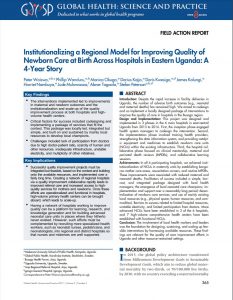
Introduction
Despite the rapid increase in facility deliveries in Uganda, the number of adverse birth outcomes (e.g., neonatal and maternal deaths) has remained high. We aimed to codesign and co-implement a locally designed package of interventions to improve the quality of care in hospitals in the Busoga region.
Key Findings
-
The interventions implemented led to improvements in maternal and newborn outcomes and the institutionalization and scale-up of the quality improvement process at both hospitals and high-volume health centers.
-
Critical factors for success included codesigning and implementing a package of services that fit the context. This package was locally led, integrated but simple, and built on and sustained by mainly local resources to develop local champions.
-
Challenges included lack of participation from doctors due to high doctor-patient ratio, scarcity of human and other resources, inadequate infrastructure, unstable electricity, and multiplicity of other initiatives.
Key Implications
-
Successful quality improvement projects must be integrated but feasible, based on the context and building onto the available resources, and implemented over a fairly long time. Creating a network of regional hospitals via a quality improvement collaborative rapidly leads to improved referral care and increased access to high-quality services for mothers and newborns. Once these efforts are operationalized and functional in hospitals, high-volume primary health centers can be brought aboard, which leads to scale-up.
-
Having a network of hospitals working to improve quality can be a platform for learning, research, and knowledge generation and for building advanced neonatal care units in places where they hitherto never existed. However, such efforts must be complemented by recruiting more specialized health workers, such as neonatal nurses, pediatricians, and neonatologists, into regional and district hospitals so that nurses and midwives are well supported.